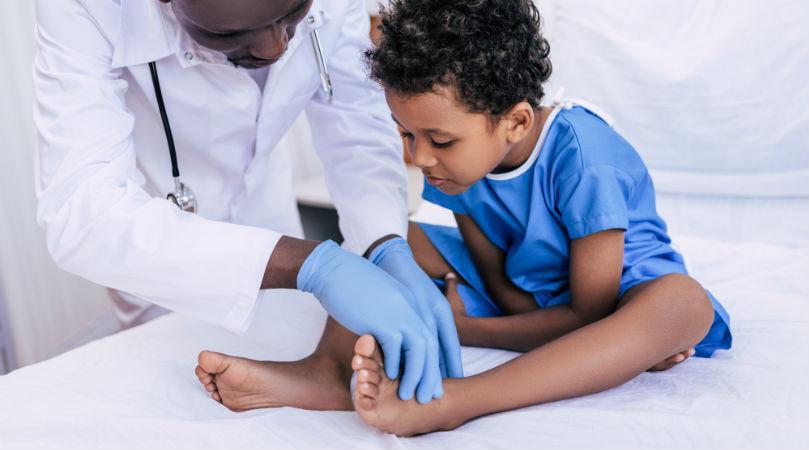Most leg injuries in children and teens occur during sports or play or from accidental falls. The risk for injury is higher in contact sports, such as wrestling, football, or soccer, and in high-speed sports, such as biking, in-line skating, skiing, snowboarding, and skateboarding. Knees, ankles, and feet are the most affected body areas. Any injury occurring at the end of a long bone near a joint may injure the growth plate and needs to be checked by a doctor.
What Does a Podiatrist Do?
Podiatrists are medical specialists who help with problems that affect your feet or lower legs. In human anatomy, the lower leg is the part of the lower limb that lies between the knee and the ankle. The thigh is between the hip and knee and makes up the rest of the lower limb. The term lower limb or “lower extremity” is commonly used to describe all of the leg. They can treat injuries as well as complications from ongoing health issues like diabetes. You might hear them called a podiatric physician or doctor of podiatric medicine.
Are Podiatrist Doctors?
Podiatrists are doctors, but they don’t go to traditional medical school. They have their own schools and professional associations. They also have “DPM” (doctor of podiatric medicine) after their names instead of “MD” (medical doctor). Podiatrists can do surgery, reset broken bones, prescribe drugs, and order lab tests or X-rays. They often work closely with other specialists when a problem affects your feet or lower legs. In the U.S., podiatrists are licensed and regulated by state governments.
How to Choose a Good Pediatric Podiatrist For Your Child
When your child needs a podiatrist, you want to make sure you get the best doctor available to you. Here is how to get the best Pediatric Podiatrist near you for your Child:
- Get a Referral
The first thing to do, even if your insurance does not require it, is to ask your pediatrician for a referral. Your regular doctor knows your child well and will also be familiar with other pediatric providers. In addition to talking to your pediatrician, ask friends and family if they’ve ever needed a podiatrist for their child. You’ll get to hear firsthand how well the doctor performed (or didn’t).
- Look at Reviews
The Internet makes it easier than ever to learn what other patients thought of a doctor. You can go to a particular review platform, such as Yelp, or search Google. Just type “pediatric podiatrist ratings” followed by your city or zip code and the search engine does the rest. When reading reviews, consider how many people have reviewed the practice. In general, a higher number of reviews is better, as it gives you a more rounded look at the provider. Also, look for the overall feel. A few negative reviews are natural, but the majority should be positive. If they aren’t, you may want to look for another podiatrist. Finally, if the negative reviews concern you even though the overall rating is high, try looking at other posts from that reviewer. You’ll see whether all of their reviews are negative or if they occasionally get service they appreciate. You may also discover they’ve reviewed businesses you frequent and you can see how well your opinions match.
- Check the Podiatrist’s Credentials
In addition to where the doctor got his or her degree, look at board memberships, such as the American Podiatric Medical Association and American Board of Podiatric Surgery. Also, don’t be afraid to call the doctor’s office and ask a few questions. How long has the doctor been in practice? What percentage of their practice is devoted to treating children? You should also find much of this information on the practice’s website.
- Do You Like the Support Staff?
A good doctor understands the importance of hiring excellent support staff. From the moment you enter, and even from that first phone call, you should feel welcome and comfortable. From the person answering the phone to whomever greets you to the medical assistant taking your child’s medical history, you should feel valued and respected.
- Is Your Child Comfortable with the Doctor?
It’s normal for kids to be a little nervous at the doctor’s office. It only becomes an issue if they remain nervous or frightened. A good pediatric podiatrist is skilled at putting children at ease. Look for a podiatrist who interacts naturally with children and with whom your child feels comfortable. In addition to talking to you, the doctor should speak directly with your child (assuming the child has the ability to communicate their issues).
- Are the Doctor’s Tools and Practices Up-to-Date?
Although gadgets don’t define the doctor, you do want a podiatrist who uses the latest proven technologies for diagnosis and treatment. For example, digital x-rays performed on-site allow the doctor to review images with you and your child right away instead of waiting for lab work.In addition to the latest diagnostic equipment, you want your provider to stay up-to-date on advances in treatment, which brings us to number seven.
- Do They Explain Your Treatment Options?
Some podiatrists go directly to surgical solutions. While there are cases where surgery is the best option, be wary of providers who advise it for everything. A good doctor describes all of your treatment options and generally considers surgery a last resort. He or she makes sure you understand your child’s condition as well as the improvement you could expect with each treatment option.
How to Protect Children From Sports Injuries
You can help protect your kids from being injured by following some simple guidelines:
Use of Proper Equipment
It’s important for kids to use proper equipment and safety gear that is the correct size and fits well. For example, they should wear helmets for baseball, softball, bicycle riding, and hockey. They also should wear helmets while they’re inline skating or riding scooters and skateboards. Ask your child’s coach about the appropriate helmets, shoes, mouthguards, athletic cups and supporters, and padding. For racquet sports, field hockey, lacrosse, basketball, softball, and baseball, ask about any protective eyewear, like shatterproof glasses.
Protective equipment should be approved by the organizations that govern each of the sports. Hockey facemasks, for example, should be approved by the Hockey Equipment Certification Council (HECC) or the Canadian Standards Association (CSA). Bicycle helmets should have a safety certification sticker from the Consumer Product Safety Commission (CPSC).
In the United States, the National Operating Committee on Standards for Athletic Equipment (NOCSAE) sets many of the standards for helmets, facemasks, and shin guards. Besides meeting the NOSCAE standards, all equipment should be properly cared for so it stays effective over time. SEE: The 5 Types of Safety Signs
Maintenance and Appropriateness of Playing Surfaces
Check that playing fields are not full of holes and ruts that might cause kids to fall or trip. Kids doing high-impact sports, like basketball and running, should do them on surfaces like tracks and wooden basketball courts, which can be more forgiving than surfaces like concrete.
Adult Supervision and Commitment to Safety
Any team sport or activity that kids participate in should be supervised by qualified adults. Select leagues and teams that have the same commitment to safety and injury prevention that you do. The team coach should have training in first aid and CPR, and the coach’s philosophy should promote players’ well-being. A coach with a win-at-all-costs attitude may encourage kids to play through injury and may not foster good sportsmanship. Be sure that the coach enforces playing rules and requires that safety equipment be used at all times.
And make sure your kids play sports that match their skill level, size, and physical and emotional maturity.
Proper Preparation
Just as you wouldn’t send a child who can’t swim to a swimming pool, it’s important not to send kids to play a sport that they’re unprepared to play. Make sure that they know how to play the sport before going out on the field.
Kids should be adequately prepared with warm-ups and training sessions before practices and before games. This will help ensure that they have fun and reduce the chances of an injury. They also should should drink plenty of fluids and be allowed periods of rest during practices and games. SEE: Safety Guidelines For Pedestrians





